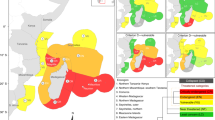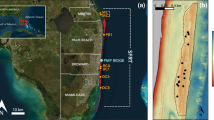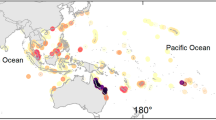Abstract
Global warming is rapidly emerging as a universal threat to ecological integrity and function, highlighting the urgent need for a better understanding of the impact of heat exposure on the resilience of ecosystems and the people who depend on them1. Here we show that in the aftermath of the record-breaking marine heatwave on the Great Barrier Reef in 20162, corals began to die immediately on reefs where the accumulated heat exposure exceeded a critical threshold of degree heating weeks, which was 3–4 °C-weeks. After eight months, an exposure of 6 °C-weeks or more drove an unprecedented, regional-scale shift in the composition of coral assemblages, reflecting markedly divergent responses to heat stress by different taxa. Fast-growing staghorn and tabular corals suffered a catastrophic die-off, transforming the three-dimensionality and ecological functioning of 29% of the 3,863 reefs comprising the world’s largest coral reef system. Our study bridges the gap between the theory and practice of assessing the risk of ecosystem collapse, under the emerging framework for the International Union for Conservation of Nature (IUCN) Red List of Ecosystems3, by rigorously defining both the initial and collapsed states, identifying the major driver of change, and establishing quantitative collapse thresholds. The increasing prevalence of post-bleaching mass mortality of corals represents a radical shift in the disturbance regimes of tropical reefs, both adding to and far exceeding the influence of recurrent cyclones and other local pulse events, presenting a fundamental challenge to the long-term future of these iconic ecosystems.
This is a preview of subscription content, access via your institution
Access options
Access Nature and 54 other Nature Portfolio journals
Get Nature+, our best-value online-access subscription
$29.99 / 30 days
cancel any time
Subscribe to this journal
Receive 51 print issues and online access
$199.00 per year
only $3.90 per issue
Buy this article
- Purchase on Springer Link
- Instant access to full article PDF
Prices may be subject to local taxes which are calculated during checkout




Similar content being viewed by others
References
IPCC. Climate Change 2014: Impacts, Adaptation, and Vulnerability (eds Field, C. B. et al.) (Cambridge Univ., Cambridge, 2014).
Australian Bureau of Meteorology. 2016 marine heatwave on the Great Barrier Reef. http://www.bom.gov.au/environment/doc/marine-heatwave-2016.pdf (2016).
Bland, L. M. et al. Developing a standardized definition of ecosystem collapse for risk assessment. Front. Ecol. Environ. 16, 29–36 (2018).
Hughes, T. P. et al. Spatial and temporal patterns of mass bleaching of corals in the Anthropocene. Science 359, 80–83 (2018).
Heron, S. F., Maynard, J. A., van Hooidonk, R. & Eakin, C. M. Warming trends and bleaching stress of the World’s coral reefs 1985–2012. Sci. Rep. 6, 38402 (2016).
Donner, S. D., Rickbeil, G. J. M. & Heron, S. F. A new, high-resolution global mass coral bleaching database. PLoS ONE 12, e0175490 (2017).
Hughes, T. P. et al. Coral reefs in the Anthropocene. Nature 546, 82–90 (2017).
Baird, A. H. & Marshall, P. A. Mortality, growth and reproduction in scleractinian corals following bleaching on the Great Barrier Reef. Mar. Ecol. Prog. Ser. 237, 133–141 (2002).
Baker, A. C., Glynn, P. W. & Riegl, B. Climate change and coral reef bleaching: an ecological assessment of long-term impacts, recovery trends and future outlook. Estuar. Coast. Shelf Sci. 80, 435–471 (2008).
Marshall, P. A. & Baird, A. H. Bleaching of corals on the Great Barrier Reef: differential susceptibilities among taxa. Coral Reefs 19, 155–163 (2000).
Loya, Y. et al. Coral bleaching: the winners and the losers. Ecol. Lett. 4, 122–131 (2001).
Hughes, T. P. et al. Climate change, human impacts, and the resilience of coral reefs. Science 301, 929–933 (2003).
Swain, T. D. et al. Coral bleaching response index: a new tool to standardize and compare susceptibility to thermal bleaching. Glob. Change Biol. 22, 2475–2488 (2016).
Hughes, T. P. et al. Global warming and recurrent mass bleaching of corals. Nature 543, 373–377 (2017).
Eakin, C. M. et al. Caribbean corals in crisis: record thermal stress, bleaching, and mortality in 2005. PLoS ONE 5, e13969 (2010).
Liu, G. et al. Reef-scale thermal stress monitoring of coral ecosystems: new 5-km global products from NOAA Coral Reef Watch. Remote Sens. 6, 11579–11606 (2014).
Beeden, R. et al. Impacts and recovery from severe tropical cyclone Yasi on the Great Barrier Reef. PLoS ONE 10, e0121272 (2015).
Kayanne, H. Validation of degree heating weeks as a coral bleaching index in the northwestern Pacific. Coral Reefs 36, 63–70 (2017).
Hock, K. et al. Connectivity and systemic resilience of the Great Barrier Reef. PLoS Biol. 15, e2003355 (2017).
Muller, E. M. et al. Bleaching increases likelihood of disease on Acropora palmata (Lamarck) in Hawksnest Bay, St. John, US Virgin Islands. Coral Reefs 27, 191–195 (2008).
Miller, J. et al. Coral disease following massive bleaching in 2005 causes 60% decline in coral cover on reefs in the US Virgin Islands. Coral Reefs 28, 925–937 (2009).
Kayanne, H., Harii, S., Ide, Y. & Akimoto, F. Recovery of coral populations after the 1998 bleaching on Shiraho Reef, in the southern Ryukyus, NW Pacific. Mar. Ecol. Prog. Ser. 239, 93–103 (2002).
Gilmour, J. P., Smith, L. D., Heyward, A. J., Baird, A. H. & Pratchett, M. S. Recovery of an isolated coral reef system following severe disturbance. Science 340, 69–71 (2013).
Webster, N. S., Soo, R., Cobb, R. & Negri, A. P. Elevated seawater temperature causes a microbial shift on crustose coralline algae with implications for the recruitment of coral larvae. ISME J. 5, 759–770 (2011).
Hughes, T. P. & Kerry, J. T. Back-to-back bleaching has now hit two-thirds of the Great Barrier Reef. The Conversation https://theconversation.com/back-to-back-bleaching-has-now-hit-two-thirds-of-the-great-barrier-reef-76092 (2017).
Great Barrier Reef Marine Park Authority. Final report: 2016 coral bleaching event on the Great Barrier Reef. http://elibrary.gbrmpa.gov.au/jspui/bitstream/11017/3206/1/Final-report-2016-coral-bleaching-GBR.pdf (2017).
Hartmann, D. L. et al. in Climate Change 2013: The Physical Science Basis. (eds Stocker, T.F. et al.) 159–254 (IPCC, Cambridge Univ. Press, Cambridge, 2013).
Hughes, T. P., Kerry, J. T. & Simpson, T. Large-scale bleaching of corals on the Great Barrier Reef. Ecology 99, 501 (2017).
Madin, J. S. et al. The Coral Trait Database, a curated database of trait information for coral species from the global oceans. Sci. Data 3, 160017 (2016).
Acknowledgements
We acknowledge support from the Australian Research Council’s Centre of Excellence Program and a Laureate Fellowship to T.P.H., from the Great Barrier Reef Marine Park Authority, and from the US National Oceanic and Atmospheric Administration. The scientific results and conclusions, as well as any views or opinions expressed herein, are those of the authors and do not necessarily reflect the views of NOAA or the US Department of Commerce. We thank T. Simpson, who provided 225 aerial scores of bleaching from the Torres Strait; M. Jacobson for assistance with statistical programming; members of the Australian National Coral Bleaching Taskforce, marine park managers and rangers, and 30 student volunteers, who participated in extensive field studies on the Great Barrier Reef throughout 2016.
Author information
Authors and Affiliations
Contributions
The study was conceptualized by T.P.H., who also wrote the first draft of the paper. All authors contributed to writing subsequent drafts. J.T.K. coordinated data compilation, analyses and graphics. Aerial bleaching surveys were conducted by T.P.H. and J.T.K. Underwater bleaching and mortality censuses were undertaken by A.H.B., A.D., A.S.H., M.O.H., M.J.M., R.J.P., M.S.P., J.S.S. and G.T. C.M.E., S.F.H., G.L. and W.J.S. provided satellite data on heat stress. M.J.M. undertook the functional trait analysis and S.R.C. provided statistical advice and modelled loss of coral cover among different taxa.
Corresponding author
Ethics declarations
Competing interests
The authors declare no competing interests.
Additional information
Publisher’s note: Springer Nature remains neutral with regard to jurisdictional claims in published maps and institutional affiliations.
Extended data figures and tables
Extended Data Fig. 1 Relationship between aerial bleaching scores and change in coral cover.
Aerial scores of bleaching on the x axis are: 0 (< 1% of colonies bleached), 1 (1–10%), 2 (10–30%), 3 (30–60%) and 4 (60–100%). Change in coral cover on the y axis was measured in situ between March and November 2016 on 98 reefs that were also scored from the air. Box plots are shown for each aerial category, showing median values (horizontal lines), boxes for values in the 25th–75th percentiles, vertical lines for values less than the 25th percentile and greater than the 75th, and data points for outliers. Medians were used when calibrating change in cover for each aerial category (see Fig. 1a).
Extended Data Fig. 2 Loss of coral cover along the Great Barrier Reef in 2016.
Losses, measured on 110 reefs between March and November 2016, range from 0 (dark green) to 100% (1–5% (green), 5–25% (light green), 25–50% (yellow), 50–75% (orange) and 75–100% (red)). Map template is provided by Geoscience Australia (Commonwealth of Australia (Geoscience Australia) 2018).
Extended Data Fig. 3 Shifts in coral cover following coral bleaching.
The frequency distribution of coral cover on 110 reefs, measured in March 2016 (solid bars) and again in November 2016 (hashed bars). Reef locations are shown in Extended Data Fig. 2.
Extended Data Fig. 4 Mortality rates differ among coral taxa.
Box plots are shown for each taxon, showing median mortality (horizontal lines), boxes for the middle two quartiles, vertical lines for the first and fourth quartiles, and data points for outliers. a, The initial mortality of corals recorded on belt transects on 43 reefs with > 60% bleaching. b, Longer term loss of cover for taxonomic categories recorded between March and November 2016 on the 43 remeasured reefs with > 60% bleaching. Taxa in a and b are plotted in rank order along the x axis, from highest to lowest decreases in mean cover between March and November 2016.
Extended Data Fig. 5 Differential sensitivity of coral taxa to temperature stress.
Sensitivity is estimated from the loss of cover on 63 reefs for different groups of corals between March and November 2016, as a function of heat exposure (DHW). The horizontal axis is the slope of the relationship between the log-ratio of final and initial coral cover (response variable) and DHW (explanatory variable). Values plotted for each taxonomic grouping (ordered from most sensitive to least sensitive) are random effects estimates, with conditional standard errors.
Extended Data Fig. 6 Bleaching extent is unrelated to mortality.
The regression shows the relationship between the levels of bleaching by individual coral taxa on severely bleached reefs (where > 60% of all colonies were affected, n = 43 reefs), and their subsequent loss of cover eight months later. The non-significant correlation indicates that the winners–losers spectrum of bleaching among taxa is a poor predictor of which ones ultimately die.
Supplementary information
Rights and permissions
About this article
Cite this article
Hughes, T.P., Kerry, J.T., Baird, A.H. et al. Global warming transforms coral reef assemblages. Nature 556, 492–496 (2018). https://doi.org/10.1038/s41586-018-0041-2
Received:
Accepted:
Published:
Issue Date:
DOI: https://doi.org/10.1038/s41586-018-0041-2
This article is cited by
-
Gene expression of Pocillopora damicornis coral larvae in response to acidification and ocean warming
BMC Genomic Data (2024)
-
Host starvation and in hospite degradation of algal symbionts shape the heat stress response of the Cassiopea-Symbiodiniaceae symbiosis
Microbiome (2024)
-
Integration of population genetics with oceanographic models reveals strong connectivity among coral reefs across Seychelles
Scientific Reports (2024)
-
A marine heatwave drives significant shifts in pelagic microbiology
Communications Biology (2024)
-
Global warming-related response after bacterial challenge in Astroides calycularis, a Mediterranean thermophilic coral
Scientific Reports (2024)
Comments
By submitting a comment you agree to abide by our Terms and Community Guidelines. If you find something abusive or that does not comply with our terms or guidelines please flag it as inappropriate.



